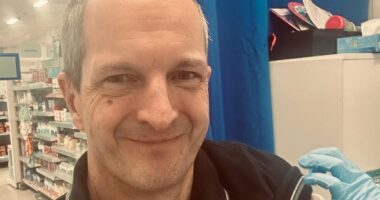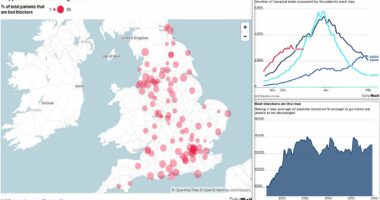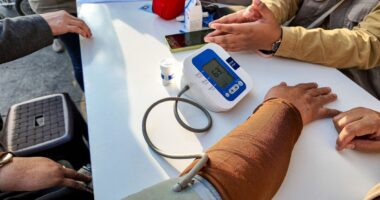Share this @internewscast.com
In the middle of the 20th century the Eastern Highlands province of Papua New Guinea was gripped by a mysterious disease which left entire villages without adult women.
The Fore people at the centre of the outbreak called it kuru – the word for shivering – as people lost control of their limbs and bodily functions before a tremor set in preceding death.
The tribe had been relatively isolated from the rest of the world until the 1930s, but by the height of the epidemic in the 1950s it had attracted the attention of researchers from around the world trying to understand the disease, which had eluded explanation.
After ruling out contaminants, researchers hypothesised it could be genetic, until the discovery that kuru was spread through the Fore’s tradition of mortuary feasts, during which they ate the bodies of their deceased relatives.
A type of prion disease, kuru is a progressive neurodegenerative disease caused by a change in the shape of the body’s normal prion protein. The most likely explanation of why it spread is that at some point one person died of a randomly occurring prion disease, such as the sporadic Creutzfeldt-Jakob disease (CJD), and then the infected tissue was consumed by the community.
Because the body was broken up and eaten in a ritualistic way according to spiritual beliefs, with certain tissues going to certain kin, women and children were worst affected by the disease – because they were apportioned the brain and spinal cord where prions are concentrated.
The kuru epidemic dwindled over decades after the mortuary feasts were outlawed in the 1950s, but a research centre in the United Kingdom has been dedicated to studying it after their own brush with an epidemic of prion disease.
The UK Medical Research Council’s prion unit at University College London was set up in the aftermath of BSE (or “mad cow disease”), which occurred when cattle were crushed up and then fed back to cattle, and which crossed the species barrier in 1995 with young people dying from variant CJD.
New research led by the unit and published this week in the American Journal of Human Genetics offers the most comprehensive genetic study of the people living in the Eastern Highlands to date, and also investigates the impact of the kuru epidemic on migration flows in the region.
Fresh genetic analysis
It was previously thought that kuru led to a decrease or even a complete stop to intermarriages between the Fore and neighbouring communities because they linked the disease to sorcery.
The new genetic analysis found no evidence either for less overall migration into areas where kuru was most severe, or a stop to the practice of patrilocality, where a bride moves to live closer to her husband’s family.
“On the contrary, we observed a significant bias toward females among migrants into high kuru incidence areas,” the authors wrote. The analysis showed the proportion of females among migrants was 25% higher in the “high” incidence kuru areas compared to the “zero/low” kuru incidence areas.
“This likely reflects the continued practice of patrilocality [where a newlywed couple lives near the husband’s family] despite documented fears and strains placed on communities as a result of kuru,” the paper concludes.
Field staff from the affected and neighbouring populations were recruited by the Papua New Guinea Institute of Medical Research (PNGIMR) to collect genetic samples through long-term community participation, which were then analysed by researchers in London and Copenhagen.
The researchers carried out genetic analysis of the region based on genome-wide genotype data of 943 individuals from 21 linguistic groups and 68 villages in the Eastern Highlands of Papua New Guinea, including 34 villages in the South Fore linguistic group, the group most affected by kuru.
Laboratory studies were approved by the PNGIMR’s advisory committee and by the research ethics committee of the UCL Institute of Neurology, with oral consent obtained from all participants before any samples were obtained, and participation of the communities involved established through discussions with village leaders, communities, families and individuals.
Earlier genetic research among the Fore people revealed that female survivors carried genetic variants in the gene that encodes prion proteins, which likely made them resistant to kuru.
Prof Simon Mead, a consultant neurologist and clinical lead of the UK National Prion Clinic, said “we found evidence that the Fore population was evolving to protect itself against the kuru epidemic, but this region had been ill-studied in the past, so we couldn’t make confident inferences about evolution without a deeper knowledge of the genetics of the populations involved.”
Dr Irene Gallago Romero, a human genomics and evolution researcher at St Vincent’s Institute for Medical Research said the question of whether the migration of women was drastic enough to change the genetic makeup of traditionally insular communities was left unanswered.
The study found “a striking degree of population structure”, or distinct genetic groups, in the region, but if rigid village boundaries were indeed broken down, a smaller degree of population structure would have been observed, Romero said.
She said it was “striking” how the study illustrated how genetics could add another dimension to the history of a relatively unknown group of people.
“[Anthropology] and genetics tell mostly complementary stories, but there are bits and pieces that are inconsistent.”
For instance, the study found that some villages that speak different languages were genetically similar, and some communities that spoke the same language were genetically different.
“So, it’s really nice to get multiple ways of looking at human societies and human populations.”
Another key finding was the existence of drastic genetic differences between linguistic groups. Researchers found more of a difference between communities in Papua New Guinea than between Spain and Finland, though some of these groups were only 45km apart. Gallago Romero attributed this to a practice of marrying within a small community.
Colin Masters, a laureate professor of neuropathology at the University of Melbourne, said the study illustrated how pandemics and epidemics, where millions of people die, have the potential to change a population’s genetic code.











